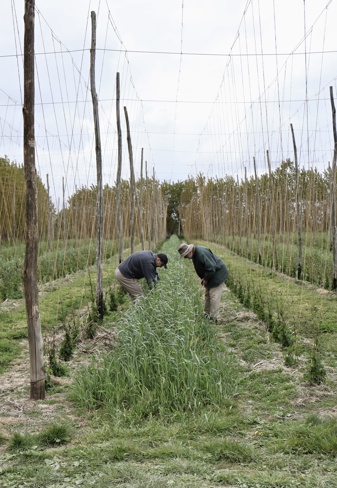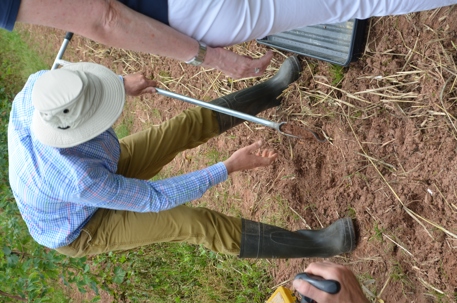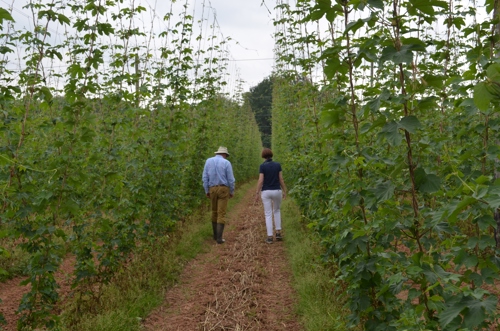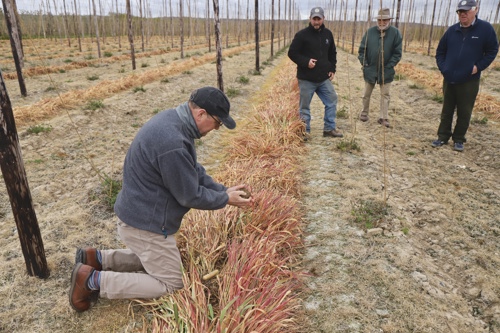




The triallists investigated growing a variety of different cover crops to build organic matter in the soil and protect it from heavy rain. The aim was to find species which did not harbour disease. Black oats and rye were chosen as the cover crop varieties with the best characteristics for use with hops.
The effect of the cover crops on organic matter, mineral nitrogen, earthworms and water infiltration rate were measured.
The effect of the cover crops on organic matter, mineral nitrogen, earthworms and water infiltration rate were measured.
There were four main ‘full evaluation’ sites where changes to all relevant soil parameters were measured during the course of the field lab.
In addition to this there were ‘observation’ sites where growers established and managed various mixes according to their own requirements, sharing their experiences but not taking detailed data beyond what is practical for them.
To read more about one of the triallist's experiences of this field lab, check out their blog.
The final report can be found in the reports section of the field lab page
• The best time to drill cover crops into hopyards is late August, just before starting hop harvest; soils are still warm and there is sufficient rain and daylight for the crop to establish.

• Narrow-leaved cereal crops like oat and rye were the preferred cover crop mix as they are resistant to Verticillium Wilt. Broadleaf cover crops are only suitable with wilt-resistant hops varieties.
• Higher seed rates are better, on hop soils a good seed rate is 50/50 rye and oat mix at around 125kg/ha.
• A narrow seed drill is required for sowing the cover crop, for which growers can adapt fertiliser spreaders.
One of the farmers tried using a crimper roller on his oat and rye mix, but reports very poor results. Terminating the cover crop before it was mature meant that it was difficult to achieve sufficient bruising and crimping to damage the cover crop. In order to lay it on the surface, the farmer had to resort to terminating the cover crop with glyphosate. However, it may be that the same degree of damage can be achieved using less glyphosate combined with using a crimper roller.
Soil assessments were intended to take place this April. However, having spent the first two years playing around with seed mixes, timings and seeding rate, the group will postpone soil sampling this year to give more accurate, longer-term readings of the impact on soils.
In the third year, two of the four farmers extended cover cropping to most of their growing area. Cover crop was planted early, following the successes of the second year.
Third year crops are currently being terminated - either sprayed off with glyphosate or gone over with a crimper roller. The group hope that the mat of foliage left by the terminated cover crop will suppress weed germination in the alleyways; this was an unexpected benefit last harvesting season.

Some of the group members have reported interest from neighbouring farmers, who have started to try cover cropping for themselves.
The second year of cover crops have now been terminated using a variety of methods as determined by each grower.
For more information see the blog page.

From the farmer:
"We chose black oats for our cover crop. This is because it is a hardy crop that would grow in the clay. And we can’t use broadleaved plants like legumes because they can carry wilt which could spread disease in the farm. So last year we broadcast it just after harvest and rolled it. It grew very well where we put it in. We tried different seed rates and discovered that it needed a higher rate of 75kg per ha. The higher the better on our soil to get a better establishment, however we had to balance that against seed cost. We let it grow all the way through the winter and just before the hops came through we put glyphosate on it to ensure it was dead, and we just let it fall over naturally. Now it’s mulching down and in a few weeks it will decompose into the soil."
Two triallists have got their cover crops in early (one before harvesting the hops) so they feel that there should be a better establishment than last year. The triallist who drilled before harvest hopes that as the seed is already in the ground waiting to emerge, as soon as the hops are harvested there will be light and more warmth than usual for them to establish much better. The triallists will be recording their observations and taking photos of emergence in order to reflect on these alongside the soil health analysis.
A new triallist has also joined the group after seeing the first year of methods rolled out.
After discussions with the researcher last November, the triallists won't be taking yield data as they don't feel this will be able to tell them clearly if the cover crops have had a beneficial effect. There are too many other confounding factors upon yield, such as rainfall, temperature and mildew.
The group's plan is take soil health measurements again in November 2019, by which time they hope that there are some significant improvements to compare against November 2017 results
The hop harvest is normally around the August bank holiday but the coordinator thinks that this will probably be a few days earlier this year due to the dry weather.
The farmers have discussed about potentially drilling in a few of the cover crops before harvest. This wasn’t thought of as a possibility due to the ground being so dry but over the weekend they have had 20 ml of rain in Kent so potentially now possible. Despite this, the farmers plan to drill the majority of the cover crops after hop harvest.
From the first year of cover cropping the group has realised a few initial lessons that can be built upon in subsequent years. These include upping the seed rate and creating a better seed bed for good cover crop establishment. The drilling of the cover crop needs to done quicker i.e. earlier in the season, so that there is less time between harvest and drilling. Next Autumn they will also look to cover a wider area with the cover crops at each farm.
Termination of the cover crops will be undertaken during late February, early March using the method of choice for each farmer, (the majority will be glyphosate this year with the hope in subsequent years the group will use other approaches such as Crimper roller).
The proposed method is to measure relevant soil parameters to establish a baseline, then areas of cover crops in alleyways, carry out follow-up evaluations to identify effects in the spring, and share best practice.
Soil measurements:
• Earthworm counts
• Water infiltration rate
• Visual evaluation of soil structure
• OM content
• Soil Mineral Nitrogen content
• Solvita test (CO2 release as an indicator of biological activity) - if practical
Cover Crop Options:
A number of parameters must be met by any candidate cover crops:
• Suitable for late summer/autumn sowing
• Easy to establish, tolerant of ‘poor’ seedbeds
• Fast growing
• Easy to kill, or manage in such a way that it does not, in itself, become a problematic weed.
• Ideally, exerts allelopathy, thereby reducing the germination of other weeds.
• Mixed stands may be more successful and resistant to pest and disease than single species.
In gardens where wilt-susceptible varieties are grown, the cover crop must not become a reservoir or nursery for wilt. Further research and consultation are needed, but this may restrict the options to monocots.
• Rye: excellent leaching prevention, useful OM useful soil structure improvement.
• Black Oat: excellent leaching prevention, excellent OM, excellent soil structure improvement
• Rye/Black Oat mix
In less wilt susceptible varieties, the list of candidate plants is potentially less restricted.
Candidate plants as above, plus:
• Buckwheat: excellent OM, not frost hardy so ‘self-destructs’, said to promote P availability.
• Rye/Vetch/Phacelia mix: useful leaching reduction, excellent OM, useful soil structure improvement.
• Black Oat/Vetch mix
• Rye/Vetch mix
• Rye/Mustard mix
Crop Destruction Options:
• Leave to degrade
• Spray off in spring
• Spray off and roll flat / roll flat and spray off (a ‘bracken roller’ with serrations to promote bruising and breakdown) may be advantageous). This approach is preferred as it potentially promotes/preserves allelopathy (inhibition of weed germination).
• Spray off and cultivate (least preferred as promotes breakdown of OM and creates a new weed seedbed).
The cover crops have been sown after harvest in alternative rows to help avoid any soil cooling effects of the cover crop in Spring which may affect soil health.
After drilling the farmers have concluded future cover crops need higher seed rates and the two Kent sites have expressed their desire to sown their cover crops just before hop harvest (August) next year.
September 2022 - final results
March 2021 - final year of cover crops terminated
March 2020 - year 3 cover crops terminated
September 2019 - Year 3 cover crops sown
March 2019 - year 2 cover crops terminated
September 2018 - year 2 cover crops established
September 2018 - Year 2 cover crops drilled
March 2018 - year 1 cover crops terminated
September 2017 - Year 1 cover crops drilled
August 2017 - Methodology agreed and field lab launches

H.L.Hutchinsons Ltd
Rob is an agronomist at H. L. Hutchinsons Ltd, providing crop protection consultancy and best practice support to fruit and hop growers. Rob has specialised in fruit agronomy for over 25 years, including 14 years with GlaxoSmithKline, primarily looking after Blackcurrants for Ribena.
Rob has a particular interest in crop research and the challenge of finding ways to improve the efficiency of resource utilisation – producing more while using less. He has led Innovate UK projects relating to perennial crops and release from dormancy following inadequate winter chill, and also precision spraying, treating apple trees as individuals.
In this section you will find reports and results from the field lab, as well as other relevant documents.